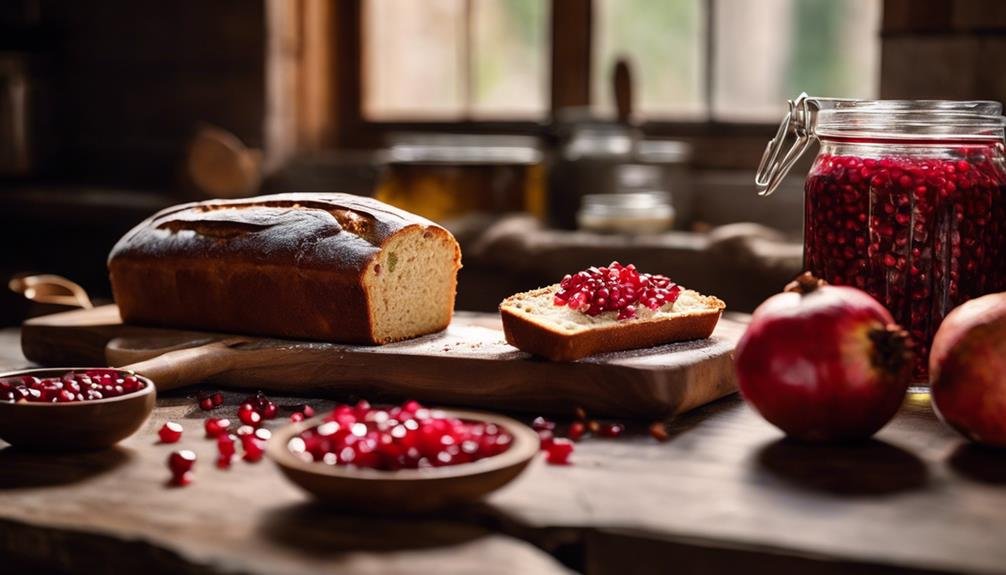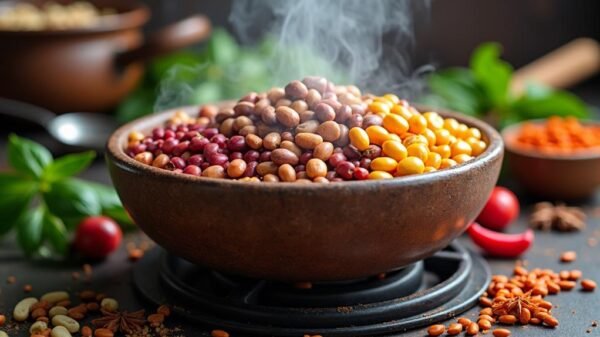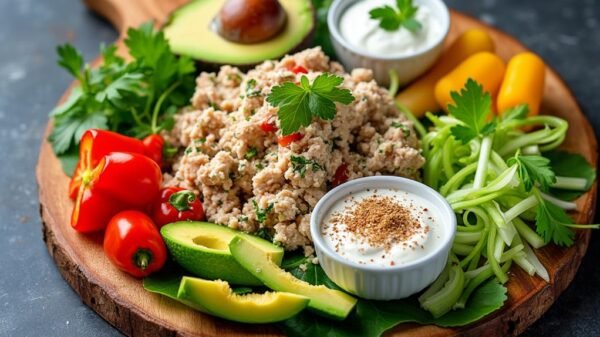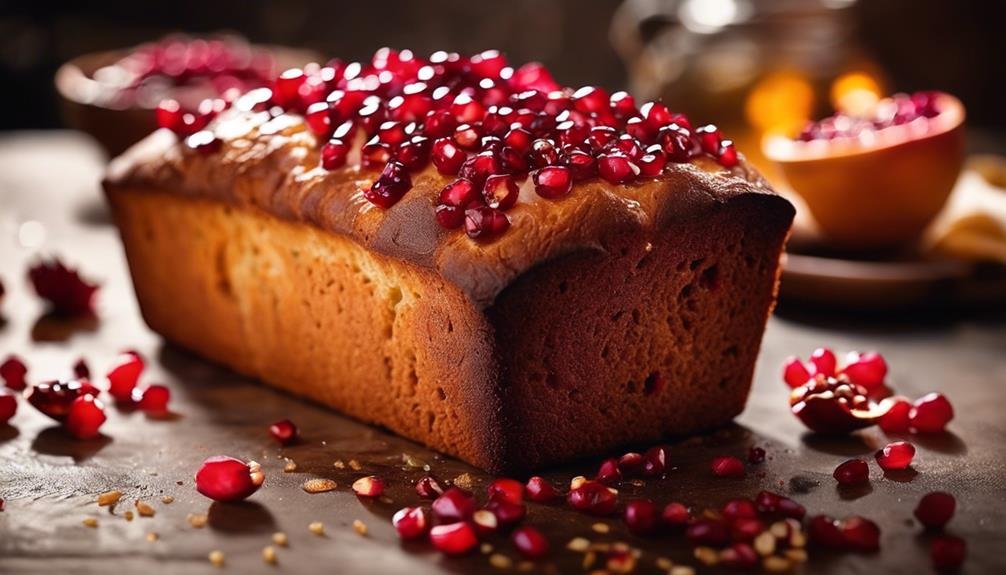You’re about to crack the code on a baking enigma with tongues wagging and ovens preheating across the land: the honeyed pomegranate bread. Imagine the marriage of science and art as you blend pomegranate’s acidity with honey’s natural fructose, creating not just bread but a symphony of flavors.
This isn’t just throwing ingredients into a bowl; it’s about understanding the chemistry that allows the pomegranate seeds to burst with flavor and how the honey caramelizes under heat, wrapping the bread in a sweet, amber hug. You’ll toast cashews to golden perfection, learning that their oils contribute not just to taste but also to a moist, tender crumb.
Now, why stop when the oven is warm, and your kitchen is about to become the stage for the next big baking sensation?
Pomegranate Bread Key Takeaways
- The recipe features unique ingredients like pomegranate arils and Bartlett pear for sweet, moist bread.
- Ingredient substitutions and vegan options offer flexibility for various dietary needs and preferences.
- Preparing this bread involves simple steps: mixing wet and dry ingredients separately and combining them for an easy bake.
- With a nutritional profile of 235 calories per serving, this honeyed pomegranate bread is a delightful treat worth discussing.
Ingredients Overview
Diving into the heart of our honeyed pomegranate bread, let’s investigate the symphony of ingredients that bring this culinary delight to life, where each component, from the juicy pomegranate arils to the sweet Bartlett pears, plays a critical role in crafting the perfect loaf. You’ll find that the backbone of this masterpiece isn’t just the Flour or the baking powder that gives it its rise but a combination that’s more akin to a well-orchestrated band than a simple mix.
Let’s not forget the eggs, the unsung heroes, working tirelessly to bind everything together, ensuring your bread doesn’t crumble under the pressure of its deliciousness. Then there’s the honey, a natural sweetener that does more than add sweetness; it’s the golden thread that weaves through the loaf, marrying flavors with its warm hug. And for the grand finale, a honey glaze that’s not merely a topping but a crowning jewel, transforming your pomegranate bread from mere baked goods to a regal offering fit for any table.
It’s a baking adventure where science meets humor. You’re the lead scientist in a lab coat dusted with Flour, wielding a whisk like a wand, ready to enchant.
Preparation Steps
In a culinary ballet of precision and flavor, you’ll begin by tenderizing the Bartlett pear’s flesh, transforming it into a juicy foundation for your honeyed pomegranate bread. This step isn’t just mashing pears; it’s an alchemy turning the ordinary into the extraordinary. You’ll coax out every drop of flavor with the finesse of a seasoned maestro, ensuring your sweet bread recipes rise to the occasion.
Next, you’ll toast the cashews to a perfect golden hue, not just for the crunch but to release a nutty aroma that sings harmoniously with your artisan pomegranate bread. Think of it as adding the violins to your kitchen’s orchestra, elevating the symphony of flavors.
And now, the magic begins as you marry the wet and dry ingredients in a union as destined as honey and pomegranates. The dance of the organic pomegranate seeds through the batter, each one a burst of tartness wrapped in sweetness, is nothing short of enchanting. It’s not just baking; crafting a masterpiece, with each step meticulously designed to bring joy to those you serve. From the honey glaze recipes to the final sprinkle of pomegranate seeds, you’re not just making a loaf but creating an experience.
Baking Guidelines

Before you set sail on this culinary adventure, make sure your oven’s heart beats at a steady 325 F, the perfect temperature to transform your batter into a golden, honeyed delight. Your vessel of choice is essential when setting off on the treacherous seas of pomegranate baking. A 9×5-inch loaf pan, greased with the loving touch of a buttery hand, will cradle your honey bread as it sets off on its transformation.
Here’s a quick checklist to make sure your bread emerges as a guide of natural sweeteners and honey-infused glory:
- Guarantee even mixing: Combine your dry and wet ingredients in separate bowls with a chemist’s precision before uniting them. This ensures a harmonious blend that’s just begging for the pomegranate arils and cashews to join the party.
- Check the baking temperature: Your oven shouldn’t waver from 325 F. An oven thermometer is your trusty sidekick in this adventure, guarding against the treachery of fluctuating temperatures.
- Test for doneness: Like checking for buried treasure, insert a toothpick into the center of the loaf. If it emerges clean, your bounty of honey bread is ready to cool and receive its honey-infused glaze.
Serving Suggestions
Improve your sensory experience by serving the honeyed pomegranate bread, either warm or at room temperature, ensuring each bite offers the perfect blend of flavors and textures. Now, let’s delve into the science of satisfaction with our serving suggestions, shall we?
To start, consider the oven your ally in the quest for the ultimate taste. Reheating slices briefly can revive that just-baked aura, optimizing the delightful interplay between the crunchy pomegranate and the lush, moist crumb fortified by whole-grain Flour.
But wait, there’s more to this culinary adventure! To lift your bread to the extraordinary, why not introduce a bit of theatrics at the table? Imagine this: a drizzle of honey cascading over your bread, its viscosity and sheen theatrically catching the light, followed by a sprinkle of sugar crystals that crackle and pop, like applause, as they hit the warm surface. And, if you’re feeling particularly daring, a dollop of Greek yogurt can act as the cloud upon which this heavenly creation rests.
These serving suggestions aren’t just about taste; they’re a full-on sensory spectacle designed to delight and impress. So, wield your serving spoon like a wand and transform each serving into a showstopper. Your audience awaits!
Substitution Tips

Diving head swap into the art of culinary customization, you’ll find that swapping ingredients in your honeyed pomegranate bread not only tailors the flavor according to your liking but also invites a delightful experiment in taste and texture. Imagine turning this staple of pomegranate desserts into a canvas where your culinary creativity can shine.
Here are three quick swaps to ponder:
- Nuts: Swap cashews for macadamia, walnuts, or hazelnuts. Each nut brings its unique crunch and flavor profile, surprising your sweet loaf recipes with every bite.
- Fruits: Instead of pomegranate, why not try dried apricots or cherries? These alternatives can add a different texture and sweetness, elevating your fruit bread recipes to new heights.
- Sweeteners: Honey is great, but maple syrup or agave nectar can offer a new dimension of sweetness to your healthy honey pomegranate bread options.
Whether you’re crafting a gluten-free honey pomegranate bread recipe or an easy honeyed pomegranate loaf for beginners, these substitutions cater to dietary needs and add a twist to your culinary repertoire. Remember, in the kitchen, you’re the artist and every ingredient is a brushstroke.
Frequently Asked Questions
Can I Use Frozen Pomegranate Arils Instead of Fresh Ones for the Honeyed Pomegranate Bread Recipe?**
For the honeyed pomegranate bread recipe, you can use frozen pomegranate arils instead of fresh ones. Thaw them first to remove any excess moisture. This approach will still yield delicious and enjoyable bread.
What Adjustments Should I Make if I Want to Bake This Bread in a Convection Oven Instead of a Conventional Oven?**
To bake bread in a convection oven instead of a conventional oven, you should decrease the temperature by 25°F, setting it to 300°F. Additionally, checking on the bread sooner than you normally would is important, as convection ovens often bake items more quickly. This ensures that your bread is baked to perfection without the risk of overcooking.
Is There a Gluten-Free Alternative for the Flour Used in This Recipe That Won’t Compromise the Texture or Taste of the Bread?**
Yes, there is a gluten-free alternative that won’t compromise the bread’s texture or taste. You can maintain the delicious texture and taste by using a high-quality gluten-free flour blend instead of regular Flour. The difference will be undetectable, ensuring you and your guests are thoroughly pleased.
How Can I Store the Leftover Honeyed Pomegranate Bread to Maintain Its Freshness and Flavor for as Long as Possible?**
To maintain the freshness and flavor of your leftover honeyed pomegranate bread for as long as possible, wrap it tightly in plastic wrap and then in foil. Place it in the refrigerator for short-term storage, which can be kept for up to a week. For longer preservation, store the wrapped bread in the freezer. When ready to enjoy it again, thaw it at room temperature.
Conclusion
Now, you’ve mastered the art of honeyed pomegranate bread, a culinary feat that’s sure to impress. Remember, the key to this delectable marvel lies in the symphony of flavors and textures – the tang of pomegranate, the sweetness of pear, and the crunch of toasted cashews.
Don’t be shy to experiment with substitutions; science and baking are best friends with a quirky sense of humor. Slice it up, serve with a smile, and watch as your creation becomes the talk of the table.
Happy baking, chef!


































